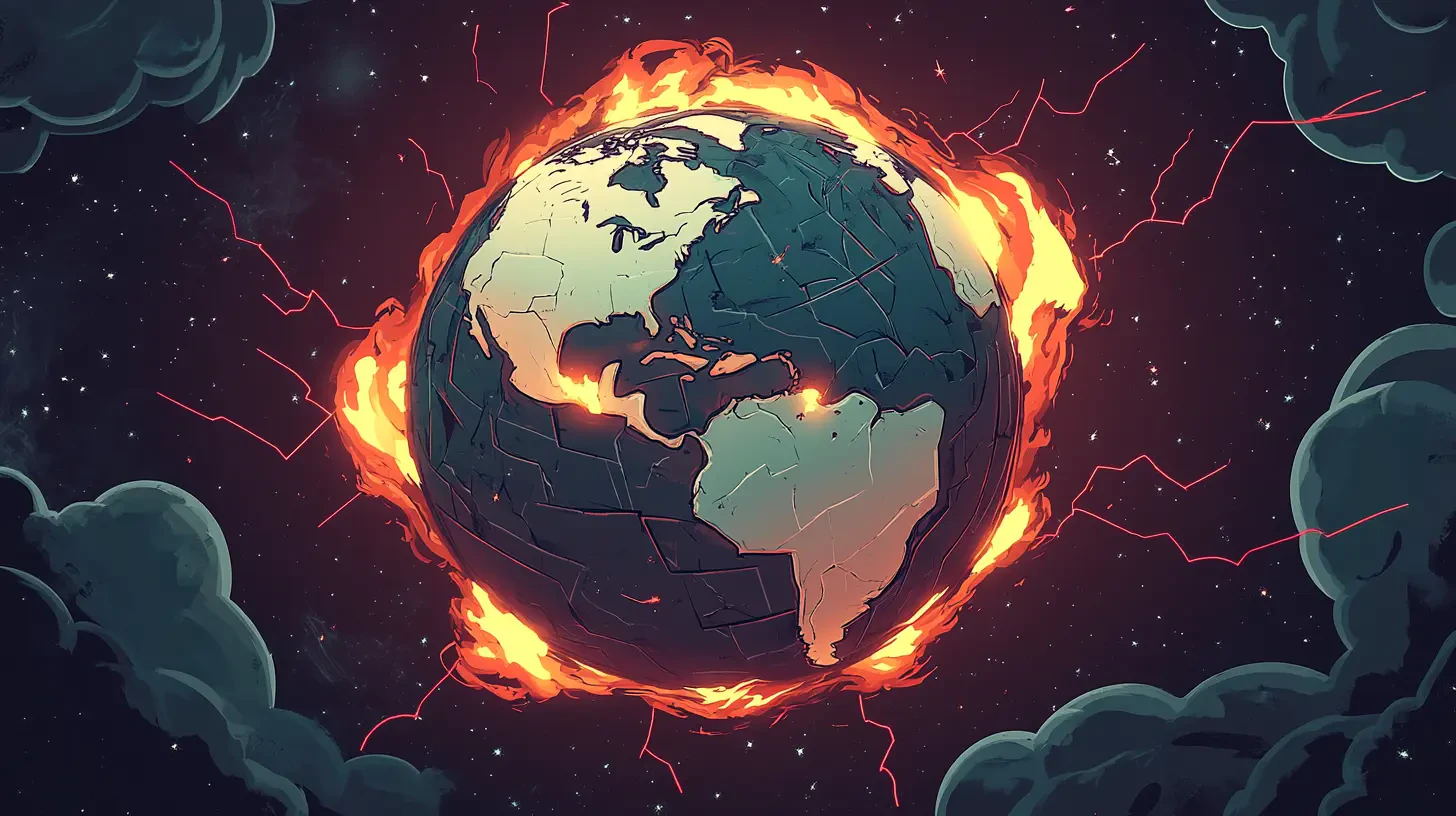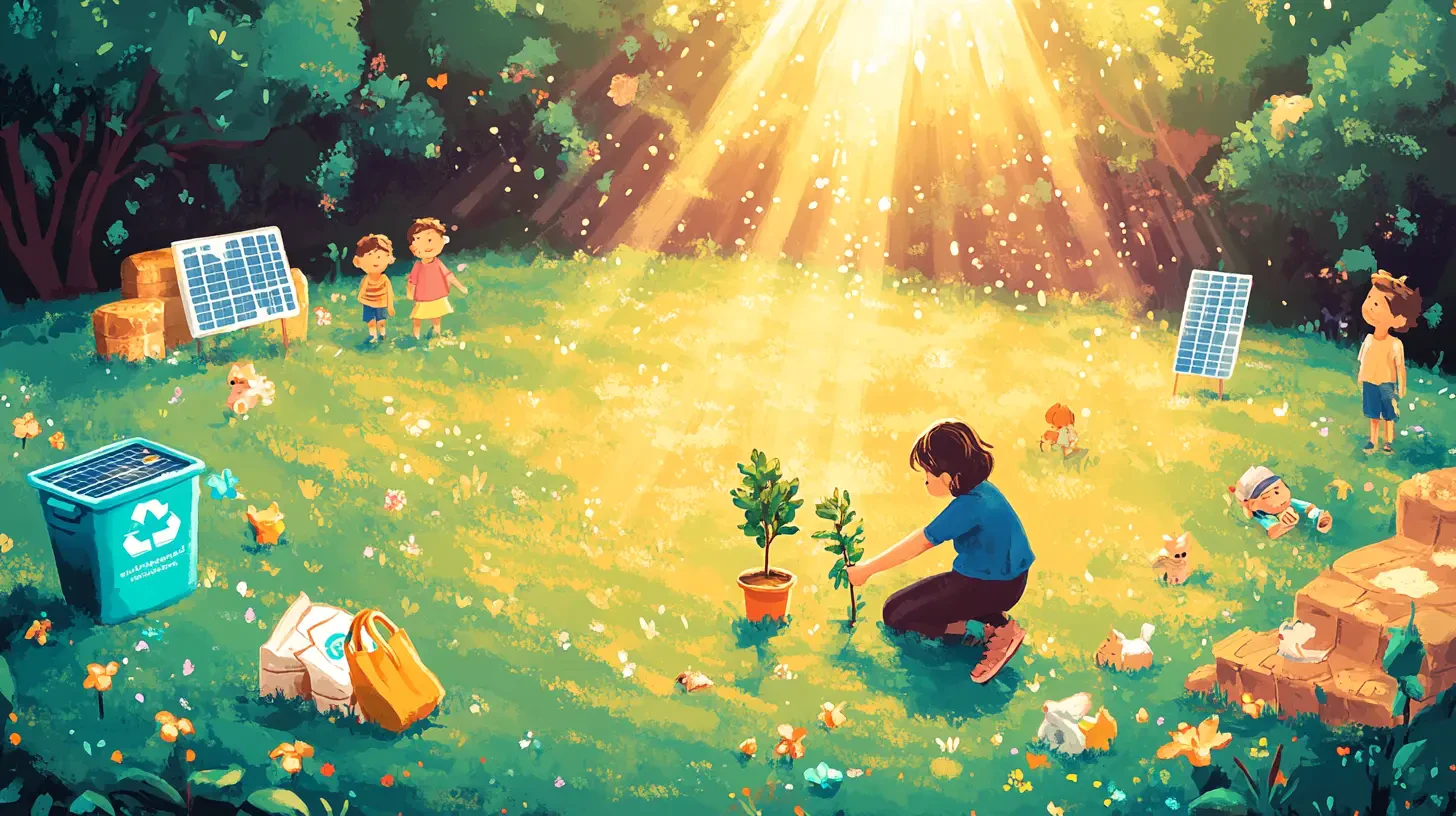Global Warming: Why is the Earth Getting Hotter and How Can We Fix It?

In recent years, our world has been warming rapidly due to global warming, caused by the accumulation of greenhouse gases emitted from various human activities. This phenomenon has had severe impacts on the environment, public health, the economy, and overall quality of life.
Global warming is no longer a distant issue—it is a crisis that demands awareness and genuine cooperation from everyone, whether at the individual, organizational, or governmental level. Together, we must work to mitigate its effects, restore the balance of nature, and build a sustainable future for the generations to come.
Understanding Global Warming: A Phenomenon the World Is Facing
Global warming is a phenomenon that is having severe and escalating impacts on both ecosystems and human life. With the Earth's average temperature rising rapidly, environmental problems are becoming increasingly serious. Understanding the causes and trends of global warming is therefore essential to prepare for and address the issue effectively.
Meaning and Causes of Global Warming
Global warming refers to the ongoing rise in the average temperature of the Earth's near-surface air and oceans. This phenomenon has become evident since the mid-20th century and is closely linked to climate change, which is a direct result of the greenhouse effect.
Greenhouse gases such as carbon dioxide, nitrous oxide, and chlorofluorocarbons (CFCs) play a significant role in trapping heat within the Earth's atmosphere. Most of these gases are produced by human activities, including the burning of fossil fuels for energy and transportation, industrial production, and deforestation. These actions have diminished the Earth's natural ability to absorb carbon dioxide.
The Intergovernmental Panel on Climate Change (IPCC) has clearly stated that the primary cause of global temperature increases over the past century is human activity. This conclusion is supported by peer-reviewed scientific research, with over 99% of experts in agreement.
Current Overview of the Global Warming Situation
Recent data highlight a worrying trend in global warming, with average temperatures continuing to rise over recent decades.
- Over the 100 years leading up to 2005, the Earth's average temperature increased by approximately 0.74 ± 0.18 degrees Celsius.
- In 2023, the global average temperature was 1.45 degrees Celsius above pre-industrial levels.
- The year 2024 was recorded as the hottest year in history, with global average temperatures exceeding the pre-industrial baseline by more than 1.5 degrees Celsius.
The situation has continued to intensify in early 2025, particularly in January, which was classified as the hottest month since temperature records began in 1850. During that month, the global temperature was 1.64 ± 0.11 degrees Celsius above the 1850–1900 average, with a peak of 1.75 degrees Celsius above pre-industrial levels.
Trends in 2025 and Future Impacts
- The United Kingdom’s Met Office has forecast that the global average temperature throughout 2025 will range between 1.29 and 1.53 degrees Celsius above pre-industrial levels, with a central estimate of 1.41 degrees Celsius. This indicates that 2025 is likely to be one of the three hottest years on record.
- Meanwhile, the research organization Berkeley Earth estimates there is a 38% chance that 2025 could become the hottest year ever recorded, surpassing 2024.
The ongoing rise in global temperatures clearly shows that climate change is not merely an environmental issue, but a global crisis that demands urgent and collective action. Reducing greenhouse gas emissions, restoring forests, and transitioning to more sustainable production and consumption patterns are key strategies to mitigate the impacts of global warming—before the world faces consequences too severe to reverse in time.
Main Cause: When Human Activities Contribute to Global Warming
The current climate change crisis is primarily driven by human activities. Scientists estimate there is more than a 95% likelihood that global warming since the 1950s is directly caused by human actions.
The Intergovernmental Panel on Climate Change (IPCC) has clearly stated that human influence has unequivocally led to rising temperatures in the atmosphere, oceans, and on land.
At the heart of the issue lies greenhouse gases, which play a critical role in trapping heat in the atmosphere and preventing it from escaping into space, resulting in a continuous rise in global temperatures.
- CO₂ (Carbon Dioxide): The most impactful greenhouse gas, carbon dioxide levels have increased by more than 48% compared to pre-industrial times. In 2021, the atmospheric concentration of CO₂ reached 414.4 parts per million (ppm), the highest level in two million years.
- CH₄ (Methane): Although methane remains in the atmosphere for a shorter period than carbon dioxide, it has a significantly higher global warming potential (GWP). Over a 20-year period, methane’s GWP is as high as 81.2 times that of CO₂.
- N₂O (Nitrous Oxide): A long-lived gas in the atmosphere, nitrous oxide is emitted from various activities such as agriculture, industry, and the burning of fossil fuels.
- Fluorinated Gases: Though present in smaller quantities, these gases have an extremely high GWP—thousands of times greater than CO₂. They are typically emitted during industrial processes, including the manufacture of electronic devices and refrigeration systems.
- Water Vapor: While not a direct cause of climate change, water vapor acts as a feedback mechanism. As the planet warms due to other greenhouse gases, more water evaporates from the oceans, increasing atmospheric water vapor and intensifying global warming.
The main human activities contributing to climate change include:
- Fossil Fuel Combustion: This is the largest source of carbon dioxide (CO₂) emissions. It stems from the use of coal, oil, and natural gas in energy production, industry, and transportation.
- Deforestation: Trees absorb and store carbon, but when they are cut down, the stored carbon is released back into the atmosphere as CO₂. This is particularly critical in tropical regions, where deforestation alone can release up to 5.6 billion tons of greenhouse gases annually.
- Agriculture and Livestock: Ruminant animals such as cows and sheep emit methane during digestion. Additionally, the use of chemical fertilizers—especially nitrogen-based ones—leads to the release of nitrous oxide, a potent greenhouse gas with high heat-trapping potential.
- Transportation and Industry: These sectors not only rely heavily on fossil fuels but also emit other greenhouse gases, such as fluorinated gases and methane, through various production processes and operations.
Considering all these factors, it is clear that human activity is the primary driver accelerating the global climate crisis. Understanding the root causes of these issues is a critical first step toward developing sustainable solutions for the future of our planet and humanity.
The Impact of Global Warming on the Environment and Humanity
In recent decades, global warming has emerged as one of humanity’s greatest challenges. Its effects extend far beyond the mere rise in temperature, permeating every dimension of the environment and human life—from intensifying natural disasters and altering ecosystems to threatening health and livelihoods.
1. Climate Change and Increased Natural Disasters
The decade between 2014 and 2023 was the hottest on record. The growing intensity and volatility of weather patterns have increased the risks faced by vulnerable populations, particularly in terms of health. Conditions such as heatstroke and heat-related stress have become more prevalent, and in severe cases, can be fatal.
There has been a marked increase in the number of natural disasters. Between 2000 and 2019, more than 7,300 disaster events were recorded—nearly double the number from 1980 to 1999. These events resulted in over 1.23 million deaths and affected more than 4.2 billion people worldwide, some more than once. A key driver behind this trend is rising global temperatures, which increase the amount of water vapor in the atmosphere. This leads to more frequent and intense storms—storms that were once considered “once-in-a-century” events now occur far more regularly.
2. Rising Sea Levels and Coastal Erosion
Rising temperatures have led to the ongoing melting of glaciers and polar ice sheets, contributing significantly to the rise in sea levels. More intense wave and wind activity has also accelerated coastal erosion. This not only damages delicate ecosystems but directly affects coastal communities—especially in island nations and densely populated coastal cities. These areas face potential losses of homes, infrastructure, and habitable land in the near future.
3. Impact on Biodiversity
Global warming has caused the extinction rate of many species to rise by 10 to 100 times above the natural rate. The primary causes include habitat destruction, deforestation, and rapid climate change.
Many animals are forced to adapt in order to survive. One common adaptation is migration. For example, some terrestrial animals are moving northward at an average rate of approximately 3.8 miles per decade, while some marine species are migrating as far as 17 miles over the same period.
In marine ecosystems, changes in sea temperature have led to coral bleaching—threatening critical habitats for marine life. Additionally, plankton, a primary food source for juvenile fish, respond more rapidly to environmental changes than fish do, creating imbalances in the food chain. This has a direct impact on fisheries, which are essential livelihoods for coastal communities.
4. Impact on Human Health
Global warming increases the risk of vector-borne diseases such as dengue fever and malaria, as environmental conditions become more favorable for the spread of these insects. Without adequate preventive measures, the number of deaths from these diseases—which already exceed 700,000 annually—could continue to rise.
In addition, air pollution linked to climate change—such as particulate matter, carbon monoxide, and sulfur dioxide—is a leading cause of respiratory illnesses, heart disease, and lung cancer, especially in densely populated urban areas.
Regarding food and water security, data from the World Health Organization shows that more than 2 billion people worldwide still lack access to safe drinking water, and over 770 million faced hunger in 2020. Unpredictable weather has led to crop failures in many areas, resulting in food shortages, rising prices, and nutritional challenges in several countries.
5. Impact on Mental Health and Migration
Climate change also affects mental health, both in the short and long term. This includes anxiety and stress following severe events such as storms or floods, as well as emotional distress caused by the need for permanent relocation when former homes become uninhabitable.
These impacts are particularly evident in coastal areas, where rising sea levels continue to displace communities and disrupt traditional ways of life.
6. Impact on the Economy
Climate change affects the economy in two major ways: by slowing down economic activity and by directly damaging property. In Thailand, the Global Risk Index ranks the country as the ninth most vulnerable to climate change worldwide, with drought risk ranked sixth. However, Thailand ranks only 39th out of 48 countries in terms of adaptive capacity.
Global warming also affects gross domestic product (GDP) through both supply and demand channels, influencing price levels and inflation. Furthermore, it is likely to worsen economic inequality, as businesses and households have varying levels of vulnerability to climate change.
Therefore, global warming is not merely an environmental issue. It is a multidimensional problem interconnected with public health, economic stability, national security, and human well-being—both now and in the future.
Approaches to Addressing and Mitigating Global Warming
Global warming is an environmental crisis caused by the accumulation of greenhouse gases in the atmosphere. Its primary causes stem from human activities such as the use of fossil fuel-based energy in industrial sectors, transportation, and agriculture. Thailand is not immune to the impacts of this phenomenon, particularly the increasingly severe and frequent changes in weather patterns. Therefore, addressing global warming requires collaborative efforts from all sectors—individuals, organizations, and the government alike.
Guidelines for Reducing Greenhouse Gas Emissions in Daily Life
- Energy Conservation at Home: Reducing electricity usage can be done through simple measures, such as setting the air conditioner to 25 degrees Celsius, using LED light bulbs, switching off and unplugging electrical appliances when not in use, and opting for renewable energy sources like installing solar panels. These practices help decrease reliance on fossil fuels.
- Sustainable Transportation: Limit the use of private cars by walking, cycling, or using public transportation. When car use is necessary, consider carpooling and planning routes in advance to minimize travel distance. For those planning to purchase a new vehicle, electric cars offer an effective way to reduce carbon dioxide emissions.
- Responsible Consumption: Adjusting consumption habits—such as reducing meat intake, increasing vegetable consumption, and buying locally produced goods—can help lower greenhouse gas emissions associated with production and transportation. Avoiding frozen foods is also recommended, as they require high energy use for storage.
- Waste Reduction and Recycling: Minimize the use of single-use plastics, switch to refillable products, and properly separate waste to enable effective recycling. Choose products with environmental certifications such as the Green Label or Carbon Label, which indicate eco-friendly manufacturing standards.
- Tree Planting: Trees play a vital role in absorbing carbon dioxide. Planting trees at home or within the community not only helps balance air quality but also increases green space and enhances long-term quality of life.
The Role of Government, Organizations, and Citizens
- Government: The government should establish clear and concrete policies, such as setting targets to reduce greenhouse gas emissions, decentralizing authority to empower communities in managing resources, allocating budgets to support vulnerable groups, and promoting the development of environmentally friendly infrastructure—such as public transportation systems and green spaces in urban areas.
- Organizations and Businesses: The private sector should recognize the environmental impact of their operations. This includes assessing their greenhouse gas emissions and implementing measures to reduce energy consumption. They should also opt for raw materials from sustainable sources, develop eco-friendly products and services, and collaborate with other sectors to advance environmental policies collectively.
- Citizens: Citizens play a vital role in societal change through behavioral adjustments in daily life, such as reducing energy use, sorting waste, and making responsible consumption choices. Additionally, participating in public policy advocacy, educating others, and engaging in local environmental conservation activities are all crucial actions that contribute to broader transformation.
- Youth: Young people are a driving force for the future of society. Learning about environmental issues from school age, taking the lead in advocacy, and expressing themselves in public forums can all spark widespread change and help advance long-term sustainable policies.
Tackling global warming cannot be achieved in isolation; it requires collaboration from all sectors—government, private enterprises, and the general public. Building strong networks, sharing knowledge, and allowing citizen participation in policy-making are key components in achieving tangible change.
While changes in individual behavior may seem minor, their cumulative impact can be significant if sustained collectively. At the same time, proactive government policies supported by all sectors will enhance the chances of mitigating the climate crisis in a more sustainable and effective way.
The Future of the World If We Don’t Stop Global Warming Today
If the world fails to seriously curb or mitigate the climate crisis, a severe and prolonged catastrophe could lie ahead. The consequences will extend far beyond rising temperatures, inevitably impacting human life, economic systems, and the environment.
1. Environmental and Ecosystem Impacts
Intensifying climate change will lead to more frequent and extreme natural disasters, such as heatwaves, wildfires, floods, and storms. Coastal cities like Miami, Shanghai, and Osaka may face chronic flooding due to rising sea levels caused by melting glaciers.
Even if humanity were to halt all greenhouse gas emissions today, the Earth could still suffer the consequences of these changes for thousands of years. This is because natural systems take extensive time to recover.
2. Economic and Social Impacts
The global economic cost of the climate crisis could soar to $38 trillion per year by 2049—twice the gross domestic product (GDP) of the European Union.
In the United States, property values could drop by over $1.47 trillion by 2055 if climate change continues unchecked. Meanwhile, agriculture across parts of Africa is facing increasing risks, particularly if global temperatures rise by 2 degrees Celsius. Crop yields in the sub-Saharan region could decline by as much as 10%.
Moreover, if the planet warms by 3 degrees Celsius, the global economy could shrink by an average of around 10%. Low-income countries would bear the brunt of this impact, due to their vulnerability and limited resources, weaker economies, and less resilient infrastructure compared to wealthier nations.
3. Health Impacts
The World Health Organization (WHO) estimates that climate change could lead to an additional 250,000 deaths annually between 2030 and 2050. The causes include malnutrition, infectious diseases, and heat-related stress. Furthermore, public health costs may rise by as much as USD 4 billion per year. This situation is also expected to widen health disparities both between nations and within individual societies.
4. Rising Temperature Trends
Despite the Paris Agreement’s aim to limit global temperature increases to below 2°C, recent reports suggest that global temperatures could rise by as much as 3°C by the end of this century. Even a 1°C increase can have severe consequences. For instance, January 2025 was recorded as the hottest month on record, with temperatures 1.75°C above historical averages. It marked the 18th out of the past 19 months where global temperatures exceeded 1.5°C continuously.
5. Changing Weather Patterns
Temperature fluctuations across the globe are uneven. Some regions have experienced extreme warming, while others, such as Greenland and the Russian Far East, have seen unusual cooling. These changes have impacted freshwater availability, prolonged wildfire seasons, and undermined water security in many regions that are now facing increasing risks.
If we fail to curb global warming today, the future may not just be a hotter planet—it could become one that is inhospitable to life. Natural disasters will intensify, economic systems may collapse, and public health will inevitably deteriorate. These conditions may soon become a new normal—one from which there is no turning back.
Pathways and Partnerships for the Future of the Planet
Reducing greenhouse gas emissions lies at the heart of tackling climate change. This includes both halting the rise of emissions in the atmosphere and enhancing the planet’s capacity to absorb them. A key part of this effort is the rapidly growing investment in renewable energy. Global renewable energy capacity is projected to increase by more than 5,500 gigawatts between 2024 and 2030.
Adapting to the impacts that are already unfolding must be addressed systematically. This includes designing resilient infrastructure, conserving wetlands and coral reefs, and implementing effective wildfire management. Nature-based approaches also play a vital role—such as restoring degraded ecosystems and managing natural resources sustainably. Annual investment in nature-based solutions (NbS) is expected to rise to USD 384 billion by 2025, more than double the current level of USD 154 billion. This surge reflects the urgency of addressing climate change, biodiversity loss, and the degradation of natural resources.
No single country can resolve the climate crisis alone. International cooperation is essential. The COP28 and COP29 conferences represent critical steps toward a transition to clean energy. Meanwhile, the 6th Global Conference on Strengthening the Link between the Paris Agreement and the 2030 Sustainable Development Goals, scheduled to be held in Copenhagen in May 2025, will serve as a key platform to accelerate collective action toward shared goals.
Ultimately, effective climate action requires collaboration across all sectors—governments, private enterprises, and citizens alike—working together to protect the planet for future generations.
About Optiwise
Optiwise offers Investor Relations & ESG consulting services, corporate website design, and IR website development. We also provide advisory services for initial public offerings (IPOs) and assists in preparing disclosure documents for public companies. Additionally, our public relations efforts aim to build credibility and enhance the corporate image.
For more information about Optiwise's services, please contact us here.


